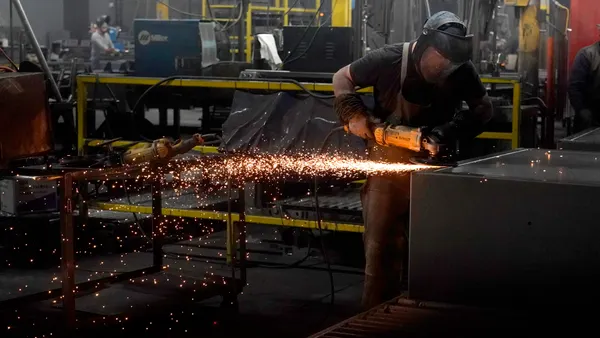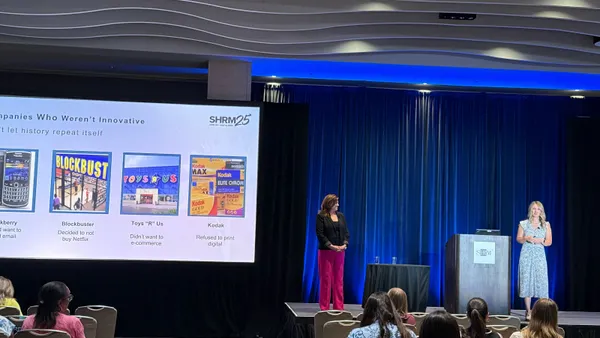Annual performance reviews — even the ones that go well — can be tense and awkward. Employees may come equipped with notes on their strengths and weaknesses, and perhaps grievances. Managers aim to dole out both constructive criticism and words of encouragement looking back over an entire year.
The difficulty inherent in such reviews has prompted some big companies, especially in the tech lane, to scrap traditional performance reviews altogether with deconstructed versions sprouting up in their stead.
On top of that, the pandemic’s strain on some companies’ finances — and the subsequent freezes on raises and promotions — also prompted employers to cut performance reviews. According to people and culture expert Gaurav Chaubey, this was especially harmful, as employees then missed out on feedback.
The problem with traditional performance reviews
Traditional performance reviews are often narrow in scope. Chaubey, co-founder of performance management system Mesh, told HR Dive that such efforts can hardly paint a vivid picture about employees' strengths, capabilities, preferences and what keeps them engaged.
Another is time. "It's just such an administrative burden for the entire organization to engage in this theoretical exercise, where they're filling out 15 to 20 questions on this really, really passive form. Some of those [questions] aren't even relevant to the individual's performance or what they worked on throughout the year," Chaubey said. "Managers spend more time filling out forms than actually sitting down with their team members to have career conversations or coaching conversations — and really understand what makes them tick and how they can actually help them grow to their potential."
Thousands of hours wrapped up in annual performance reviews is what spurred Donna Morris, Adobe’s former senior vice president of people resources (now chief people officer at Walmart), to scrap them entirely. Time was also a factor in Accenture leadership’s decision to bump annual reviews and employee rankings in 2015. Marcus Buckingham, ADP Research Institute’s head of people and performance research, and Ashley Goodall, then Cisco Systems’ senior vice president of leadership and team intelligence, found that Deloitte’s feedback process "consumed close to 2 million hours a year" before its 2015 redesign.
"As we studied how those hours were spent, we realized that many of them were eaten up by leaders’ discussions behind closed doors about the outcomes of the process," Buckingham and Goodall wrote in Harvard Business Review. "We wondered if we could somehow shift our investment of time from talking to ourselves about ratings to talking to our people about their performance and careers — from a focus on the past to a focus on the future."
Solution #1: Opt for more frequent feedback
Chaubey said an approach that includes more frequent feedback informs employees on how they can "be 1% better every day." Take Adobe, for example. After Morris kicked the traditional format to the curb, the company adopted the Adobe Check-In. This model provides ongoing feedback and dialogue, free of formal written reviews. Employees discuss priorities with managers often and those discussions are supplemented by quarterly feedback meetings. Gone, too, are the ratings and rankings that made employees feel "undervalued and uninspired."
In short, having lots of little conversations over time may lead to big results.
Solution #2: Make it personal
"Performance reviews, especially those cookie cutter standardized forms, are essentially from an era where every industrial worker was supposed to be a procedural worker," Chaubey said. Embracing employee individuality could be difficult, especially for older companies. But if ever a prototype existed for shaking up institutions, take General Electric. Despite decades of a "vitality curve," known colloquially as a "rank and yank," GE leadership managed to eliminate performance reviews from its feedback toolbox.
The company bumped rankings more than a decade ago and in 2015, adopted an app, PD@GE. Every employee has their near-term goals ("priorities"), while managers have frequent discussions with direct reports ("touchpoints") and can give or request feedback at any time ("insights"). GE employees can input typed notes or voice memos as a part of their feedback. Then users categorize feedback either as something to continue doing or consider changing.
Generally speaking, Chaubey said, "A sense of belonging really starts to come in, where [employees] have a personalized experience — where they know that there is visibility and appreciation for their unique set of strengths. And there's visibility and recognition for the unique set of preferences on the problems that they'd like to work on."
Solution #3: Check your bias
A key shortcoming of performance interviews is idiosyncratic rater bias, Chaubey said. This can look like over-prioritizing certain skills. This can involve "halo" bias, wherein positive performance in certain areas affect the whole review, or its opposite, "horns" bias. Experts also warn against affinity bias or alienation bias, where managers can rank employees based on similarities or dissimilarities.
Solution #4: Disintegrate hierarchy
Chaubey recommended "driving an open culture" where anyone can request or share appreciation. A common alternative to traditional performance reviews is 360° feedback, where employees receive insight from direct reports and supervisors. This is what Netflix does, implementing a "stop, start, continue" structure. (These reviews happen in March and April, with annual compensation reviews happening separately in October and November.)
Transparency is another important element that remains at the forefront of review redesign conversations. Chaubey drew a link between transparency and an emphasis on inclusion and belonging. "Are the CEO’s or the leadership team’s goals transparent? Are my goals transparent and open for anyone to engage in, collaborate on?" Chaubey asked. "If I'm a knowledge worker and I can pull up Elon Musk's Twitter account to know what's up at SpaceX or what's up at Tesla? And literally get a blow-by-blow account? I kind of feel entitled — and rightly so — that I should have that visibility about my own CEO."













